

The fungus you want in your walls. This post was written by a clever student who took my new Medical and Veterinary Mycology class in 2009.
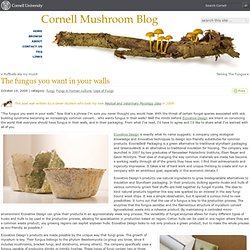
“The fungus you want in your walls.” Now that’s a phrase I’m sure you never thought you would hear. With the threat of certain fungal species associated with sick building syndrome becoming an increasingly common concern… who wants fungus in their walls? Well the minds behind Ecovative Design are intent on convincing the world that everyone should have fungus in their walls, and in their packaging.
From what I’ve read, I’d have to agree and I’d like to share what I’ve learned with all of you. Ecovative Design is exactly what its name suggests; a company using ecological knowledge and innovative techniques to design eco-friendly substitutes for common products. Ecovative Design’s products use natural ingredients to grow biodegradable alternatives to insulation and Styrofoam packaging. Ecovative Design’s products are made possible by the unique way that fungi grow.
All Natural - Metropolis Magazine - July-August 2013. Two Philadelphia University students successfully grow a lamp and a chair from mushrooms.
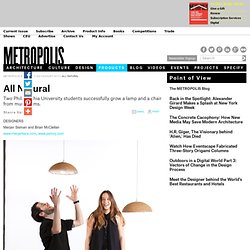
Starre Vartan DESIGNERS Merjan Sisman and Brian McClellan www.merjantara.com, www.pemoj.com Brian McClellan (left), grew his pendant lamp from oyster mushroom mycelium. Merjan Sisman (right) designed her chair using reishi mushroom roots. Courtesy Seth Shimkonis “Experiment” is the word that pops up, like mushrooms after a rainstorm, when Merjan Sisman and Brian McClellan describe their industrial design thesis project at Philadelphia University.
Mycelium’s advantages are numerous: It takes minimal energy; it’s made from renewable materials (mushroom spores and an organic substrate, usually agricultural waste); it’s fire- and heat-resistant; and it’s completely compostable. Bioremediation with Fungi and Compost. Bioremediation of petroleum-hydrocarbon contaminated soils using an ecosystem-based approach in the Yukon by: Kawina Robichaud This 2-year bioremediation project started in May 2013.
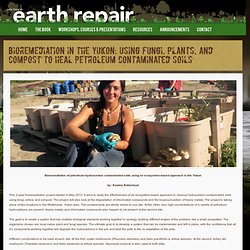
It aims to study the effectiveness of an ecosystem-based approach to cleanup hydrocarbon-contaminated soils using fungi, willow and compost. The project will also look at the degradation of chlorinated compounds and the bioaccumulation of heavy metals. The project is taking place at two locations in the Whitehorse, Yukon area. The goal is to create a system that has multiple biological elements working together in synergy, tackling different angles of the problem; like a small ecosystem.
Different combinations is be used at each site. The main role of the fungi is to degrade the hydrocarbons. Growing. 43. Fungi Biogeochemical Cycles. Fungus. Biological kingdom, separate from plants and animals A characteristic that places fungi in a different kingdom from plants, bacteria, and some protists is chitin in their cell walls.
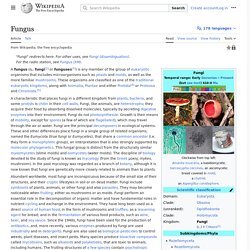
Fungi, like animals, are heterotrophs; they acquire their food by absorbing dissolved molecules, typically by secreting digestive enzymes into their environment. Fungi do not photosynthesize. Growth is their means of mobility, except for spores (a few of which are flagellated), which may travel through the air or water. Fungi are the principal decomposers in ecological systems. Biogeochemical cycle. In Earth science, a biogeochemical cycle or substance turnover or cycling of substances is a pathway by which a chemical substance moves through both biotic (biosphere) and abiotic (lithosphere, atmosphere, and hydrosphere) compartments of Earth.
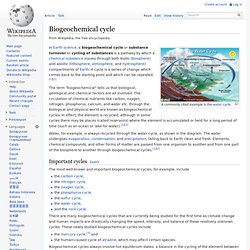
A cycle is a series of change which comes back to the starting point and which can be repeated.[1][2] The term "biogeochemical" tells us that biological, geological and chemical factors are all involved. The circulation of chemical nutrients like carbon, oxygen, nitrogen, phosphorus, calcium, and water etc. through the biological and physical world are known as biogeochemical cycles.
The Project Gutenberg eBook of The Mushroom Edible and Otherwise, by M. E. Hard. Gró - Wikipedia, frjálsa alfræðiritið. Gró eru kynfrumur í kynlausri æxlun sem geta dreifst og geymst um lengri tíma við óhagstæðar umhverfisaðstæður.

The Kingdom of Fungi - Mushrooms Are Neither Plants Nor Animals. By Natasha Longo January 20, 2012 from PreventDisease Website Spanish version For Thousands of Years, Cultures Have Revered The Health Benefits of Mushrooms.
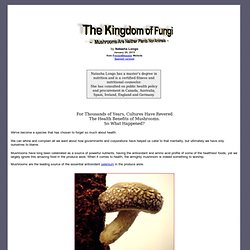
Wild About Mushrooms: Part 4. What is a Mushroom?

The mushroom we see and eat is a part of the reproductive structure of a plant we know as a "fungus. " The sole purpose of this organ is to manufacture and spread spores to reproduce its species. The part of the plant we don't usually see, the threadlike mycelium living in soil, wood, animal, or plant tissues, constitutes the vegetative portion of the plant. This is the structure of the organism that takes nourishment from living or dead organic material and the earth around it. Most of the tissues of a fungus are composed of mycelium that forms the parts seen with the naked eye.
Some mushrooms are parasitic, such as the oak-tree fungus, Armillaria mellea (honey mushroom). What about the food value of mushrooms? In Asia, fungi have been intensely studied in the hope that their use can supplement dietary protein.
HOLY CRAP! Kandle heeter. Candle Powered Air Heater - DIY Radiant Space Heater - flower pot heater - Easy DIY. Ecovative. Paul Stament. Phil Ross Artist. Encyclopedia Britannica.